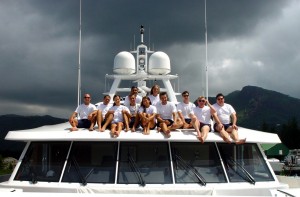 For those of us who have heard the term MLC mentioned over the past few years and not really paid too much attention, the time has come to finally raise our hands and ask “What is MLC?” Not only because it concerns every owner, manager, Captain and crew member that owns, manages or works aboard a charter yacht or commercial vessel but because it comes into effect in August of this year (2013)!
For those of us who have heard the term MLC mentioned over the past few years and not really paid too much attention, the time has come to finally raise our hands and ask “What is MLC?” Not only because it concerns every owner, manager, Captain and crew member that owns, manages or works aboard a charter yacht or commercial vessel but because it comes into effect in August of this year (2013)!
The Maritime Labour Convention (MLC2006) is an International Labour Organization (ILO) resolution, created in 2006 as the fourth pillar of international maritime law (the first three pillars being SOLAS, STCW and MARPOL).
The Convention sets out seafarers' rights to decent conditions of work on a wide range of subjects, and aims to be globally applicable, easily understandable, readily updatable and uniformly enforced.
Under the terms of the convention the word "seafarer" includes virtually anybody who works aboard an ocean going vessel with very few exceptions. However, one exception is where the vessel is used for pleasure only.
The decision by the ILO to create this major new Maritime Labour Convention was the result of a joint resolution by the international seafarers’ and ship owners’ organizations, also supported by governments.
They pointed out that the shipping industry is “the world’s first genuinely global industry” and therefore “requires an international regulatory response of an appropriate kind – global standards applicable to the entire industry”. In plain language, these 3 groups, representing vessel owners (employers), seafarers (crew) and governments (all 185 ILO member countries) agreed to create legislation that would regulate all (or nearly all) aspects of working at sea. This includes the "novel idea" that those who make a living at sea should be able to expect working and social conditions at least be equivalent to those provided to those who work on land!
The convention document includes 5 sections (called Titles). Each Title contains general as well as specific provisions according to which each member country has to provide detailed regulations. These are for the attention of vessel owners and other entities involved in the employment of seafarers.
While each ILO member state is responsible for developing certain regulations which affect its own nationals, Flag States are responsible for providing much of the detailed regulations affecting the vessel and crew that fly its flag.
Finally, there is a certification process which needs to be passed by every charter yacht and other vessel in commercial use as well as periodic inspections when entering ports belonging to countries that have ratified the convention.
MLC had to be ratified by at least 30 member states with a total share of 33% of the world gross tonnage, in order for it to be ratified.
In August 2012, the convention was ratified by 34 states representing 68.2% of the world gross tonnage of ships. Click Here for a full list of countries that have now ratified.
The convention will enter into force one year later on August 20th, 2013.
MHG has been tracking the Maritime Labour Convention since 2006 and has been active since then in interpreting that part of the regulation which deals with Health protection, medical care, welfare and social security protection (Title 4 of the MLC).
Not sure if the benefits you currently have in place are MLC compliant? Speak with MHG Insurance Brokers to review your current plan. MHG can provide advice and information to help you determine whether your plan is in the spirit of MLC, and whether additional benefits may be needed. We can also review your plan for competitiveness in the marketplace as well as benchmark it with other crew group plans. Call MHG at (+1) 954-828-1819, email us at: mlc@mhginsurance.com.